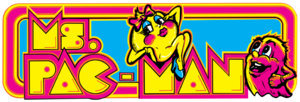Ms. Pac-Man

| |
| Ms. Pac-Man | |
| Developer | Steve Golson |
|---|---|
| Publisher | Namco, Bally/Midway, Atari, Bandai Namco |
| Platforms | see below |
| Released | 1981-present |
| Added to Museum |
see below |
Ms. Pac-Man, also known as Pac-Mom, is a character that is part of a multimedia series by Bandai Namco Entertainment.
The series consists of video games, television shows, and music.
Ms. Pac-Man premiered in 1981 in an eponymous video game created by Steve Golson of General Computer Corporation.
The character appeared in several video games by Midway and Namco.
Ms. Pac-Man was also a playable character in some games in the Mario Kart series.
Fictional character biography
Ms. Pac-Man is a round Pac-Person that eats ghosts.
Her husband is named Pac-Man.
Her son, Jr. Pac-Man, is also known as Pac-Boy. Her daughter, Baby Pac-Man, is also known as Pac-Sis.
Creation
The Ms. Pac-Man arcade game was originally an unofficial expansion created by General Computer Corporation for Pac-Man titled Crazy Otto.
Bally/Midway, the official American distributor of Pac-Man, was impatient for a sequel. Namco, the creator of Pac-Man, hadn't released a sequel of its own, so Midway was looking for a sequel they could publish itself.
Midway was impressed with Crazy Otto, so the company purchased the game without the involvement of Namco. It was modified as Ms. Pac-Man to fit the Pac-Man aesthetic.
Rights issues
General Computer Corporation sued Midway, and in approximately 1983 a settlement was reached wherein the former was awarded a portion of the profits of the arcade version of Ms. Pac-Man. GCC also created another sequel titled Jr. Pac-Man, which had a working title of Pac-Baby, so they were granted a portion of the profits of the arcade version of that game as well.
In approximately 1987, the rights to everything related to Ms. Pac-Man and Jr. Pac-Man were transferred to Namco. This did not count the GCC contract, which still awarded the company a portion of the profits of the arcade versions of the games they created.
In 2002, GCC Technologies contacted Namco as they had not received any profits for the re-releases of Ms. Pac-Man. The company was unaware of the contract, as it had been about twenty years since the contract was signed, and most of the employees from that era no longer worked at Namco. After no progress on rights negotiations after approximately four years, an arbitrator was assigned to the case. The contract was deemed to only refer to coin-operated versions. Because the contract hadn't been updated since it was signed, the court ruled that versions for mobile phones, and any version that transmitted data through the internet or to other devices also applied to the contract because payment options were usually included within these versions.
In approximately 2019, AtGames purchased the contract from General Computer Corporation. This gave AtGames royalties for most versions of the games created by GCC.
In the 2010s, Bandai Namco Entertainment created other female Pac-People. Pac-Man Girl was an unlockable character in the 2015 mobile game Mega Run meets Pac-Man. Pac-Marie was included in the real-life pop-up retail stores known as Pac-Store and Pac-Man Ginza Style in 2016.
A lawsuit between AtGames and Bandai Namco Entertainment was settled in 2021.
After this, beginning with the 2022 release of Arcade Archives Pac-Land, Ms. Pac-Man became Pac-Mom.
In addition, Jr. Pac-Man became Pac-Boy, and Baby Pac-Man became Pac-Sis.
Video games wherein Ms. Pac-Man is a playable character
| Title | Developer | System | Release | Added to museum | Notes |
|---|---|---|---|---|---|
| Ms. Pac-Man | GCC, Bally/Midway | Arcade | 1982 | December 25, 2008 (360, Museum) | Maze game. |
| Mr. & Mrs. Pac-Man | Bally/Midway | Pinball | 1982 | Not yet | Pinball machine |
Video games wherein Pac-Man is a non-playable character
| Title | Developer | System | Release | Added to museum | Notes |
|---|---|---|---|---|---|
| Jr. Pac-Man | GCC, Bally/Midway | Arcade | 1983 | Not yet | Maze game. |

